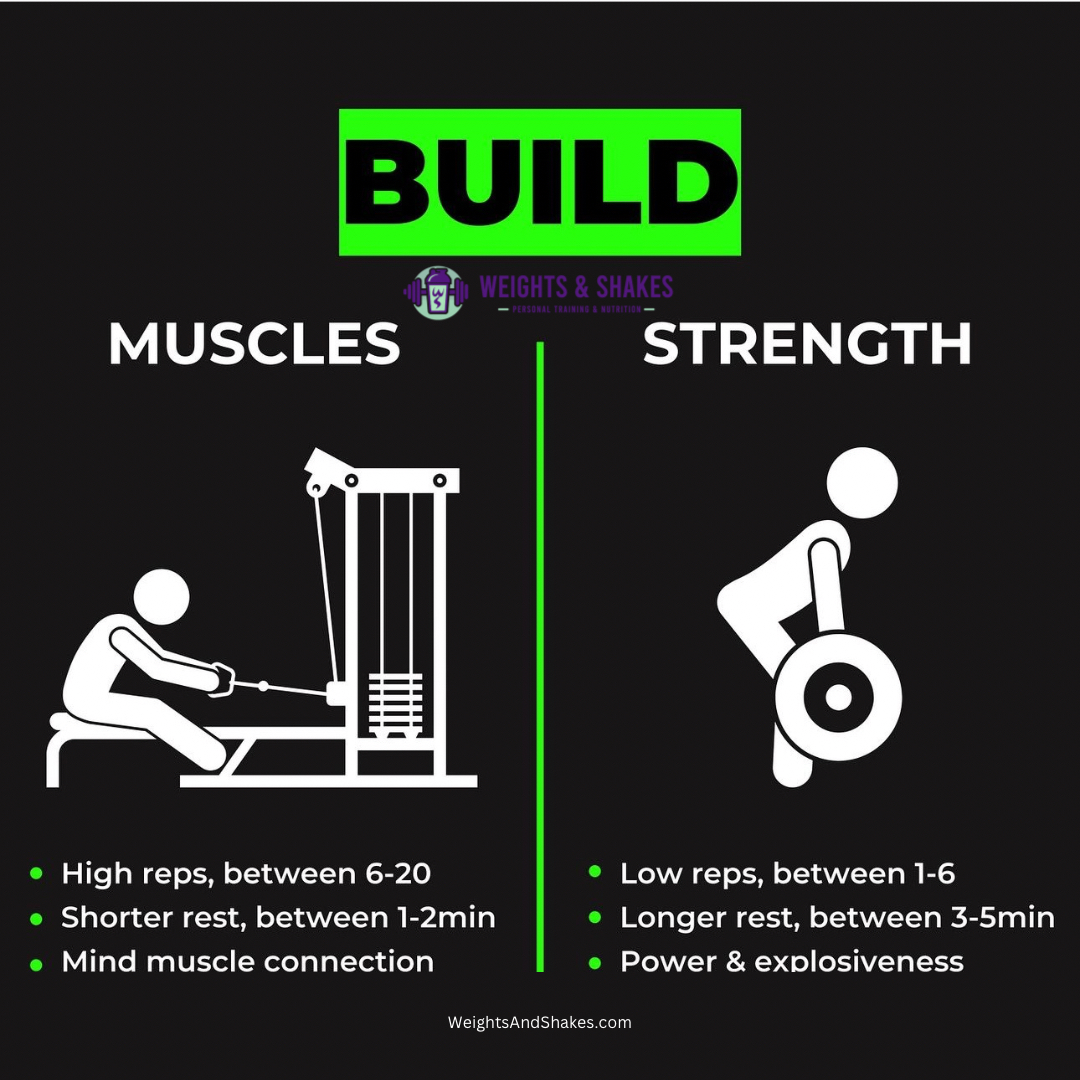Sign Up for Newsletter
When it comes to transforming your body, the journey of building muscle versus building strength is like choosing between two powerful engines: one designed for speed and aesthetics, the other for raw power and endurance. While these goals often overlap, Weights & Shakes understands the distinct approaches to muscle hypertrophy (building muscle size) and strength training (enhancing your power output) and we can elevate your fitness game to new heights!
Whether you’re a seasoned gym-goer or a beginner, this Weights & Shakes guide will help you craft workouts that align with your goals, ensuring every rep, set, and rest period brings you closer to your desired outcome. Feel free to complete our questionnaire for additional advice and tips.
Muscle Building (Hypertrophy)
Muscle hypertrophy focuses on increasing the size of your muscle fibers, leading to those coveted sculpted, fuller muscles. The key to hypertrophy is time under tension, pushing your muscles to near exhaustion with each set, which stimulates growth.
- Reps and Sets:
For hypertrophy, aim for 3-4 sets of 8-12 reps per exercise. This rep range has been shown to maximize muscle fiber recruitment while allowing for a balance between weight load and endurance. The higher end of the rep range (10-12) targets slower-twitch muscle fibers, while the lower end (8-10) engages the fast-twitch fibers.
- Rest Periods:
Rest periods should be kept relatively short, around 60-90 seconds between sets. This short recovery time keeps your muscles engaged and builds metabolic stress, a critical factor in muscle growth. However, don’t be afraid to push it to 2 minutes if the exercise involves compound movements like squats or deadlifts, which demand more recovery.
- Purpose:
The primary purpose of hypertrophy training is aesthetic enhancement. You’re sculpting your physique, emphasizing muscle definition, and creating symmetry. It’s about increasing the cross-sectional area of your muscles, which, in turn, contributes to that “bigger” look.
- Tips for Success:
- Progressive Overload: Gradually increase the weights you lift to continuously challenge your muscles. This could mean adding more weight, doing an extra rep, or slowing down your tempo.
- Mind-Muscle Connection: Focus on the target muscle during each exercise. Visualize the muscle contracting and elongating to enhance engagement and effectiveness.
- Variety: Change up your exercises every 4-6 weeks to prevent plateaus and keep your muscles guessing.
Strength Building
 Strength training is about maximizing the amount of force your muscles can produce. This type of training primarily targets the nervous system, improving how your brain communicates with your muscles to lift heavier weights.
Strength training is about maximizing the amount of force your muscles can produce. This type of training primarily targets the nervous system, improving how your brain communicates with your muscles to lift heavier weights.
- Reps and Sets:
Strength training revolves around lower rep ranges with heavier weights. Aim for 4-5 sets of 3-6 reps per exercise. The focus here is on quality over quantity—each rep should be performed with near-maximal effort.
- Rest Periods:
Rest periods should be longer, typically 2-3 minutes between sets. This extended recovery time allows your muscles and nervous system to fully recharge, ensuring you can exert maximum force on your next set. For powerlifting movements like the squat, deadlift, and bench press, you might even extend your rest to 4-5 minutes, especially if you’re lifting near your 1-rep max.
- Purpose:
The purpose of strength training is functional power. It’s about being able to move heavier loads efficiently, which translates to real-world strength. Whether you’re looking to improve your athletic performance or just want to lift heavy with confidence, strength training is key.
- Tips for Success:
- Lift Heavy: Focus on compound movements like squats, deadlifts, and bench presses, which engage multiple muscle groups and maximize strength gains.
- Technical Precision: Perfect your form to prevent injuries and ensure that you’re lifting efficiently. The better your form, the more weight you’ll be able to move.
- Consistency: Strength gains come from consistent effort over time. Make sure you’re hitting your big lifts regularly, ideally at least twice a week.
Balancing Muscle and Strength
While muscle and strength are different goals, they are not mutually exclusive. Incorporating both types of training into your routine can lead to a well-rounded physique and better overall performance. For example, you can focus on hypertrophy one day with 3-4 sets of 8-12 reps on accessory exercises, then switch to strength training with 4-5 sets of 3-6 reps on your big lifts another day.
Whether you aim to pack on muscle mass or increase your raw strength, tailoring your workouts to your specific goals will yield the best results. Remember, building muscle requires time under tension and short rest periods, while building strength demands heavy lifting and longer rest intervals. By understanding and applying these principles, you can unlock your body’s full potential.
Looking to take your fitness journey to the next level? Whether you’re sculpting a masterpiece or forging raw power, Weights & Shakes is here to fuel your gains. Dive into our protein-packed shakes, crafted to support your unique goals—because when it comes to muscle and strength, we’ve got your back!
Related Articles
Health & Wellness, Uncategorized




